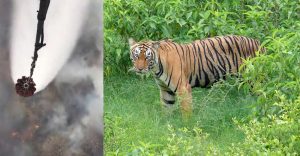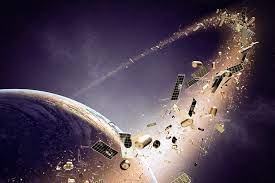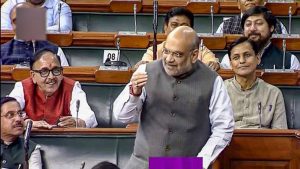Today Current Affairs: 1st April 2022 for UPSC IAS exams, State PSC exams, SSC CGL, State SSC, RRB, Railways, Banking Exam & IBPS, etc
Table of Contents
Pradhan Mantri Awas Yojna Gramin: New Beneficiaries

The Prime Minister inaugurated 5.21 lakh houses of beneficiaries of Pradhan Mantri Awas Yojna (PMAY)-Gramin in Madhya Pradesh.
- Pradhan Mantri Awas Yojna Gramin was launched by the Ministry of Rural development to achieve the objective of “Housing for All” by 2022, the erstwhile rural housing scheme Indira Awaas Yojana (IAY) was restructured to PMAY-G w.e.f 1st April, 2016.
- Objectives:
- To provide a pucca house with basic amenities to all rural families, who are homeless or living in kutcha or dilapidated houses by the end of March 2022.
- To help rural people Below the Poverty Line (BPL) in construction of dwelling units and upgradation of existing unserviceable kutcha houses by providing assistance in the form of a full grant.
- Beneficiaries:
- People belonging to SCs/STs (Scheduled Castes/Scheduled Tribes), freed bonded labourers and non-SC/ST categories, widows or next-of-kin of defence personnel killed in action, ex servicemen and retired members of the paramilitary forces, disabled persons and minorities.
- Selection of Beneficiaries:
- Through a three stage validation – Socio Economic Caste Census 2011, Gram Sabha, and geo-tagging.
- Cost Sharing:
- The cost of unit assistance is shared between Central and State Governments in the ratio 60:40 in plain areas and 90:10 for North Eastern and hilly states.
- Features:
- The minimum size of the house has been increased to 25 sq.mt (from 20sq.mt) with a hygienic cooking space.
- The unit assistance has been increased from Rs. 70,000 to Rs. 1.20 lakh in plain and from Rs. 75,000 to Rs. 1.30 lakh in hilly states.
- The assistance for construction of toilets shall be leveraged through convergence with Swachh Bharat Mission-Gramin (SBM-G), MGNREGS or any other dedicated source of funding.
- Convergence for piped drinking water, electricity connection, LPG gas connection etc. different Government programmers are also to be attempted.
IONS Maritime Exercise 2022:

The maiden edition of Indian Ocean Naval Symposium (IONS) Maritime Exercise 2022 (IMEX-22) was conducted at Goa and in the Arabian Sea.
IMEX-22:
- The exercise witnessed participation of 15 out of the 25 member nations of IONS.
- The aim of the exercise was to enhance interoperability in Humanitarian Assistance and Disaster Relief (HADR) operations among member navies.
- The exercise is seen as a significant stepping stone for regional navies to collaborate and respond collectively to natural disasters in the region and paves way for further strengthening regional cooperation.
Indian Ocean Naval Symposium:
- IONS is a premier forum for cooperation and collaboration among navies of littoral states of the Indian Ocean Region.
- The inaugural IONS Seminar was held in New Delhi in February, 2008.
- It is a voluntary initiative that seeks to increase maritime cooperation among navies of the littoral states of the Indian Ocean Region by providing an open and inclusive forum for discussion of regionally relevant maritime issues.
- There are 36 littoral states in the Indian Ocean which have been geographically grouped into the following four sub-regions.
- South Asian Littorals – Bangladesh, India, Maldives, Pakistan, Seychelles and Sri Lanka
- West Asian Littorals – Bahrain, Iran, Iraq, Kuwait, Oman, Qatar, Saudi Arabia, UAE and Yemen
- East African Littorals – Comoros, Djibouti, Egypt, Eriteria, France, Kenya, Madagascar, Mauritius, Mozambique, Somalia, South Africa, Sudan and Tanzania
- South East Asian and Australian Littorals – Australia, Indonesia, Malaysia, Myanmar, Singapore, Thailand and Timor Leste.
- The forum has enabled discussions on regional maritime issues, promoted friendly relationships, and significantly improved maritime security cooperation in the Indian Ocean Region.
- It endeavours to generate a flow of information between naval professionals that would lead to common understanding and possibly cooperative solutions on the way ahead.
Massive Fire Inside Sariska Tiger Reserve : Rajasthan

A massive fire broke out inside the Sariska Tiger Reserve (Rajasthan). The fire spread and destroyed around 10 sq km of forests despite timely satellite warnings and the availability of a real-time mobile application-based fire response system.
- The United Nations Environment Programme (UNEP) warned in its annual Frontiers report released in February 2022 that wildfires a natural phenomenon have become more dangerous and now affect larger areas.
- A total of 381 forest fires have been reported in India by 30th March, 2022, according to the Forest Survey of India. Madhya Pradesh has recorded the highest number of fires at 133.
- The fire began because of dry grass, leaves and plants because of reasons unknown to the park authorities.
- Sariska Tiger Reserve is located in Aravali hills and forms a part of the Alwar District of Rajasthan.
- Sariska was declared a wildlife sanctuary in 1955 and was declared the tiger reserve later in 1978, making it a part of India’s Project Tiger.
- The Reserve houses ruined temples, forts, pavilions and a palace.
- Kankarwadi fort is located in the centre of the Reserve and it is said that Mughal emperor Aurangzeb had imprisoned his brother Dara Shikoh at this fort in struggle for succession to the throne.
- The Reserve also houses a famous temple of lord Hanuman at Pandupole related to Pandavas.
- The Reserve is immensely rich in flora and fauna, and is famous for Royal Bengal Tiger.
- The park has populations of leopards, Nilgai, Sambar, chital etc.
MATLAB Software:

For the first time in the country, academic users in India will be able to access the MATLAB software suite at no cost through the Indian Science Technology and Engineering facilities Map (I-STEM) portal.
- MATLAB is a proprietary multi-paradigm programming language and numeric computing environment developed by MathWorks.
- MATLAB, used by more than 4 million users globally, allows matrix manipulations, plotting of functions and data, implementation of algorithms, creation of user interfaces, and interfacing with programs written in other languages.
- The software suite is hosted on the cloud server of I-STEM to provide user friendly access from anywhere in India.
- It is expected to assist many students and researchers in the country, especially those in the more remote and less-endowed institutions, thereby enhancing learning outcomes and promoting Research & Development efforts across India.
- I-STEM is a National Web portal for sharing R&D (Research and Development) facilities.
- The portal facilitates researchers to access slots for the use of equipment, as well as to share the details of the outcomes, such as, patents, publications and technologies.
- In July, 2021, I-STEM project was accorded an extension for five years, until 2026 and entered its second phase with added features.
- Launched in January 2020, it is an initiative of Office of the Principal Scientific Adviser to the Government of India under the aegis of Prime Minister Science, Technology and Innovation Advisory Council (PM-STIAC) mission.
- PM-STIAC is an overarching Council that facilitates the Principal Scientific Adviser’s Office to assess the status in specific science and technology domains, comprehend challenges in hand, formulate specific interventions, develop a futuristic roadmap and advise the Prime Minister accordingly.
- The goal of I-STEM is to strengthen the R&D ecosystem of the country by connecting researchers with resources.
- Promoting technologies and scientific equipment development indigenously, and providing necessary supplies and support to researchers by enabling them an access to existing publicly funded R&D facilities in the country through the I-STEM web portal.
PM-YUVA Scheme : Translation Of Books In Different Languages

The Government has decided that the books selected under the PM-YUVA Scheme are translated into different Indian languages to ensure the exchange of Indian culture and literature in order to promote `Ek Bharat Shreshtha Bharat’.
PM Yuva Yojana:
- Pradhan Mantri – Mentorships’s Scheme for Young writers (PM-YUVA) has been launched by the Ministry of Education on 29 May 2021 for young writers up to the age of 30 years.
- Aim of this scheme is to create young aspiring writers into skilled writers representing the rich heritage of India.
- Through the scheme, new writers will be allowed to participate and become future writers through a mentorship program.
Key objectives of the scheme are:
- Engage youth of the country in rich Indian history and culture.
- Creating a pool of young authors in the country who will be the modern/ young ambassadors of our Indian Literature.
- Create young learners for future leadership roles to represent the country on an international level.
- To help young authors project their ideas on an international platform, therefore allowing them to promote Indian literature and culture globally.
- Building skilled writers from new aspiring authors in various genres by providing expert mentoring.
Implementation:
- The scheme would be implemented by the National Book Trust under the Ministry of Education. The scheme would be implemented in a phase-wise structure.
- In Phase I– training, the selected candidates would be provided by the NBT for three months.
- In Phase II– The candidates selected would expand their understanding and also hone their skills through an interactive process at various events internationally organized, such as book fairs etc.
Ranveer Singh Bestowed The UAE Golden Visa:

Bollywood A-lister Ranveer Singh was bestowed the UAE golden visa on March 29 in Abu Dhabi. He’s the latest Bollywood talent to be granted the ten-year permit.
- So far, more than 10 Bollywood actors have got their UAE golden visas.
- In 2019, the United Arab Emirates (UAE) implemented a new system for long-term residence visas, thereby enabling foreigners to live, work and study in the UAE without the need of a national sponsor and with 100 per cent ownership of their business.
- The Golden Visa system essentially offers long-term residency (5 and 10 years) to people belonging to the following groups:
- investors, entrepreneurs, individuals with outstanding talents the likes of researchers, medical professionals and those within the scientific and knowledge fields, and remarkable students.
Eligibility requirements:
For investors:
- A deposit of at least AED (United Arab Emirates Dirham) 10 million worth of public investment, either in the form of an investment fund or a company.
- 60% of the total investment must not be in the form of real estate.
- The invested amount must not be loaned, or in case of assets, investors must assume full ownership.
- The investor must be able to retain the investment for a minimum of three years.
- May be extended to include business partners, providing that each partner contributes AED 10 million.
- Can also include the holder’s spouse and children, as well as one executive director and one advisor.
For individuals with specialized talents:
- The category includes doctors, researchers, scientists, investors and artists. These individuals may be granted a 10-year visa following accreditations granted by their respective departments and fields. The visa also extends to their spouses and children.
Eligibility for a 5-year visa:
- The investor must invest in a property of a gross value of not less than AED 5 million.
- The amount invested in real estate must not be on loan basis.
- The property must be retained for at least three years.
Outstanding students:
- Outstanding students with a minimum grade of 95% in public and private secondary schools.
- University students within and outside the country having a distinction GPA of at least 3.75 upon graduation.
Space Junk:

With space junk posing increasing threat to Indian assets in space, the Indian Space Research Organisation (ISRO) is building up its orbital debris tracking capability by deploying new radars and optical telescopes under the Network for Space Objects Tracking and Analysis (NETRA) project.
- A space debris tracking radar with a range of 1,500 km and an optical telescope will be inducted as part of establishing an effective surveillance and tracking network under NETRA.
- The government has given the go-ahead for the deployment of the radar, which will be capable of detecting and tracking objects 10 cm and above in size, he said. It will be indigenously designed and built.
- Radars and optical telescopes are vital ground-based facilities for keeping an eye on space objects, including orbital junk.
- Space junk or debris consists of spent rocket stages, dead satellites, fragments of space objects and debris resulting from ASAT.
- Hurtling at an average speed of 27,000 kmph in LEO, these objects pose a very real threat as collisions involving even centimetre-sized fragments can be lethal to satellites.
- For protecting its space assets, ISRO was forced to perform 19 collision avoidance manoeuvres (CAM) in 2021, of which 14 were in Low Earth Orbit (LEO) and five in the geostationary orbit.
- The number of CAMs jumped from just three in 2015 to 12 in 2020 and 19 in 2021.
Delhi Municipal Corporation (Amendment) Bill, 2022:

The Delhi Municipal Corporation (Amendment) Bill, 2022 was passed by Lok Sabha.
- The Bill seeks to amend the Delhi Municipal Corporation Act, 1957 passed by Parliament.
- The Act was amended in 2011 by Delhi Legislative Assembly to trifurcate the erstwhile Municipal Corporation of Delhi into:
- (i) North Delhi Municipal Corporation,
- (ii) South Delhi Municipal Corporation, and
- (iii) East Delhi Municipal Corporation.
- The Bill seeks to unify the three corporations.
- The Bill replaces the three municipal corporations under the Act with one Corporation named the Municipal Corporation of Delhi.
- The Act as amended in 2011 empowers the Delhi government to decide various matters under the Act such as total number of seats of councillors, delimitation of wards etc. The Bill instead empowers the central government to decide these matters.
- The Act provides that the number of seats in the three corporations taken together should not be more than 272. The Bill states that the total number of seats in the new Corporation should not be more than 250.
- The Act provides for a Director of Local Bodies to assist the Delhi government and discharge certain functions.
- The Bill omits the provision for a Director of Local Bodies.
- The Bill provides that the central government may appoint a Special Officer to exercise powers of the Corporation until the first meeting of the Corporation is held after the commencement of the Bill.
Mes Aynak:

The Taliban regime in Afghanistan has said it would protect the ancient Buddha statues in Mes Aynak, also the site of a copper mine where the Taliban are hoping for Chinese investment.
- Previously, they brought down the centuries-old Buddha statues in Bamiyan using artillery, explosives, and rockets.
- The apparent change of heart over the Mes Aynak statues seems to be driven by economic interests, with the regime in desperate need of the income Chinese investment in the copper mines could generate.
The ancient Bamiyan Buddhas:
- The Bamiyan valley, in the Hindu Kush mountains and along the river Bamiyan, was a key node of the early Silk Routes, emerging as a hub of both commercial and cultural exchange.
- The Bamiyan Buddhas were great examples of a confluence of Gupta, Sassanian and Hellenistic artistic styles.
- They are said to date back to the 5th century AD.
- They were once the tallest standing Buddhas in the world.
- They were called Salsal and Shamama.
- Salsal means “light shines through the universe”; Shamama is “Queen Mother”.
- UNESCO included the remains in its list of world heritage sites in 2003.
Fifth BIMSTEC Summit:

The Bay of Bengal Initiative for Multi-Sectoral Technical and Economic Cooperation (BIMSTEC) grouping’s fifth summit took place in Colombo, Sri Lanka (Host for the Fifth Summit).
- The signing of the BIMSTEC Charter was the main outcome of this summit.
- Under this Charter, the members were expected to meet once every two years.
- With the Charter, the BIMSTEC now has an international personality. It has an emblem, it has a flag.
- It has a formally listed purpose and principles that it is going to adhere to.
- In line with the development of the organisation into a formal structure, the leaders of the member-countries have agreed to divide the working of the grouping into seven segments, with India providing leadership to the security pillar.
- The summit saw the declaration of the Master Plan for Transport Connectivity that would provide a framework for regional and domestic connectivity.
- Member countries also signed a treaty on mutual legal assistance on criminal matters.
- A Memorandum of Association (MoA) on the establishment of BIMSTEC Technology Transfer Facility (TTF) in Colombo, Sri Lanka.
- India will provide the (BIMSTEC) secretariat USD 1 million US dollars to increase its operational budget.
BIMSTEC:
- The Bay of Bengal Initiative for Multi-Sectoral Technical and Economic Cooperation (BIMSTEC) is a regional organisation comprising seven Member States: five deriving from South Asia, including Bangladesh, Bhutan, India, Nepal, Sri Lanka and two from Southeast Asia, including Myanmar and Thailand.
- This sub-regional organisation came into being on 6 June 1997 through the Bangkok Declaration.
- With 21.7% of the world’s population and a combined Gross Domestic Product (GDP) of USD 3.8 trillion, BIMSTEC has emerged as an influential engine of economic growth.
- The BIMSTEC Secretariat is in Dhaka.
World Energy Transitions Outlook 2022:

The International Renewable Energy Agency (IRENA) launched the World Energy Transitions Outlook 2022 at the Berlin Energy Transition Dialogue.
- The Berlin Energy Transition Dialogue (BETD) has become a leading international forum for key stakeholders of the energy sector.
- Energy transition refers to the global energy sector’s shift from fossil-based systems of energy production and consumption — including oil, natural gas and coal — to renewable energy sources like wind and solar, as well as lithium-ion batteries.
- The Outlook sets out priority areas and actions based on available technologies that must be realised by 2030 to achieve net zero emissions by mid-century.
- It also takes stock of progress across all energy uses to date, which shows that the current pace and scale of the renewables-based transition is inadequate.
- It provides in-depth analysis of two areas particularly relevant for the decarbonisation of end-use sectors: electrification and bioenergy.
- It also explores the socio-economic impacts of the 1.5°C pathway (under Paris Agreement) and suggests ways to speed progress towards universal access to clean energy (renewable energy).
Findings of the Outlook:
- Global annual additions of renewable power will triple by 2030 as recommended by the Intergovernmental Panel on Climate Change.
- At the same time, coal power will have to resolutely be replaced, fossil fuel assets phased out and infrastructure upgraded.
- The Outlook sees electrification and efficiency as key drivers of the energy transition, enabled by renewables, hydrogen, and sustainable biomass.
- End-use decarbonisation will take centre-stage with many solutions available through electrification, green hydrogen, and the direct use of renewables.
- High fossil fuel prices, energy security concerns and the urgency of climate change underscore the pressing need to move faster to a clean energy system.
New Findings About Pluto:

New findings about Pluto have been reported by the National Aeronautics and Space Administration’s (NASA) New Horizons probe.
- The probe reported that icy lava flows have recently (no more than a billion years ago) covered substantial tracts of its surface.
- The findings drew particular attention to a mountainous feature named Wright Mons.
- The only spacecraft to visit Pluto is NASA’s New Horizons, which passed close by in July 2015.
- A mountainous feature named Wright Mons was found on Pluto, which rises 4-5km above its surroundings.
- It is about 150km across its base and has a central depression (a hole) 40-50km wide, with a floor at least as low as the surrounding terrain.
- Wright Mons, was informally named by the New Horizons team in honour of the Wright brothers.
- Scientists claim that Wright Mons is a volcano, and cite the lack of impact craters as evidence that it is not likely to be older than 1-2 billion years.
- An impact crater is formed when an object like an asteroid or meteorite crashes into the surface of a larger solid object like a planet or a moon.
- Its volume exceeds 20 thousand cubic kilometres.
- Although considerably less than the volume of Mars’s biggest volcanoes, this is similar to the total volume of Hawaii’s Mauna Loa, and much greater than the volume of its above sea-level portion.
- The slopes of Wright Mons and much of its surroundings are seen to be crowded with hummocks up to 1km high and mostly 6-12km across.
- Scientists conclude that these hummocks are made primarily of water-ice, rather than nitrogen- or methane-ice that covers some other young regions on Pluto.
- They argue that this is consistent with the material strength necessary to form and preserve these domes, but they do recognise small patches of much weaker nitrogen-ice, mainly in the central depression.
- The hummocks were likely created by some sort of ice volcanism, known by the technical term “cryovolcanism” – erupting icy water rather than molten rock.
- Pluto’s bulk density shows that it must have rock in its interior, but its outer regions are a mixture of ices (water, methane, nitrogen and probably ammonia and carbon monoxide, too, all of which are less than a third as dense as rock) in the same way that the crust of the Earth and other rocky planets is a mixture of several silicate minerals.
- Many other areas of Pluto have been around long enough to accumulate large numbers of impact craters – no recent icy lava flows have covered them.




